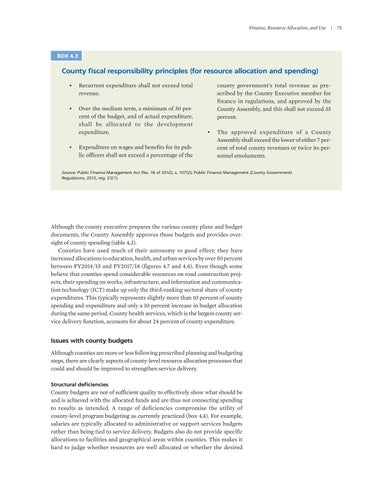Finance, Resource Allocation, and Use
|
BOX 4.3
County fiscal responsibility principles (for resource allocation and spending) •
Recurrent expenditure shall not exceed total revenue.
•
Over the medium term, a minimum of 30 percent of the budget, and of actual expenditure, shall be allocated to the development expenditure.
•
Expenditure on wages and benefits for its public officers shall not exceed a percentage of the
county government’s total revenue as prescribed by the County Executive member for finance in regulations, and approved by the County Assembly, and this shall not exceed 35 percent. •
T he approved expenditure of a County Assembly shall exceed the lower of either 7 percent of total county revenues or twice its personnel emoluments.
Source: Public Finance Management Act (No. 18 of 2012), s. 107(2); Public Finance Management (County Government) Regulations, 2015, reg. 25(1).
Although the county executive prepares the various county plans and budget documents, the County Assembly approves those budgets and provides oversight of county spending (table 4.3). Counties have used much of their autonomy to good effect; they have increased allocations to education, health, and urban services by over 50 percent between FY2014/15 and FY2017/18 (figures 4.7 and 4.8). Even though some believe that counties spend considerable resources on road construction projects, their spending on works, infrastructure, and information and communication technology (ICT) make up only the third-ranking sectoral share of county expenditures. This typically represents slightly more than 10 percent of county spending and expenditure and only a 10 percent increase in budget allocation during the same period. County health services, which is the largest county service delivery function, accounts for about 24 percent of county expenditure.
Issues with county budgets Although counties are more or less following prescribed planning and budgeting steps, there are clearly aspects of county-level resource allocation processes that could and should be improved to strengthen service delivery. Structural deficiencies
County budgets are not of sufficient quality to effectively show what should be and is achieved with the allocated funds and are thus not connecting spending to results as intended. A range of deficiencies compromise the utility of county-level program budgeting as currently practiced (box 4.4). For example, salaries are typically allocated to administrative or support services budgets rather than being tied to service delivery. Budgets also do not provide specific allocations to facilities and geographical areas within counties. This makes it hard to judge whether resources are well allocated or whether the desired
75


